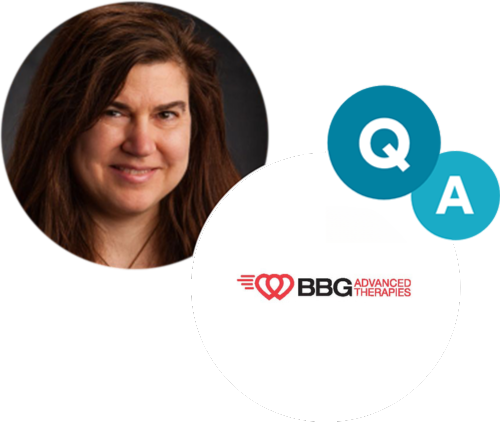

I'm Heather Munoz, MN, RN, CPN, CPHON, QIA, and my journey into biotherapies began with hands-on experience in blood collection and apheresis-skills that laid the foundation for a career focused on advancing patient care through innovation.
What started as curiosity about the human body's resilience evolved into a passion for pediatric nursing, especially focused on hematology and oncology. I've worked across major health care hubs, witnessing the rise of cell and gene therapies and supporting families through some of the most critical moments of their lives.
A chance encounter with an apheresis machine reignited my early training, leading me to specialize in this under-taught but vital field. Since then, I've performed hundreds of apheresis procedures, built programs from the ground up and trained clinicians nationwide.
Today, I lead business development for starting materials and clinical research, leveraging clinical insight to streamline access, reduce barriers and ensure therapies reach patients without delay. My mission is simple: deliver science with compassion and make every step of the patient journey seamless.

BBG Advanced Therapies plays a critical and timely role in the cell and gene therapy space. What makes it so unique is that it didn't emerge overnight, it evolved from BioBridge Global, a nonprofit with more than 50 years of experience in blood and cellular services. That legacy gives us a foundation of trust, quality and compliance that few others can match. As the field has rapidly advanced, so have we.
BBG Advanced Therapies was recently created to meet the specific and growing needs of the cell and gene industry—offering fully integrated, customizable solutions that span from the collection and processing of starting materials to cellular testing and biomanufacturing. We're not just a service provider; we're a strategic partner helping deliver transformative therapies through innovative, patient-centered solutions.
What sets us apart is our dedicated infrastructure and client-centric approach. We've built a platform that's agile enough to support cutting-edge therapies, backed by our decades of experience. That's how BBG Advanced Therapies accelerates access, improves patient outcomes and fulfills the mission of saving and enhancing lives.
Access remains one of the persistent, and heartbreaking, challenges in the cell and gene therapy space, and at BBG Advanced Therapies, we've decided to tackle it head on. Geographic disparity impacts access to therapy. Patients living more than two hours from a cellular therapy treatment center are up to 40% less likely to receive treatment. In many parts of the United States, the average distance to an authorized treatment center is more than 100 miles. These aren't just statistics; they represent the disparity that real patients face in accessing treatment, show real delays, and in some cases, a missed chance at life-saving therapies solely based on a patient's home address.
We have seen this challenge firsthand through our health care infrastructure in San Antonio, Texas. Despite being in a state with major medical facilities determined to care for those needing cell and gene therapies, we've encountered patients and donors who face travel and logistical hurdles to access leukapheresis services. This insight was very much a driving force behind the creation of our mobile leukapheresis center.
Our mobile leukapheresis center is a fully equipped, regulatory-compliant extension of our fixed-site capabilities-designed to bring leukapheresis directly to patients and donors in underserved, rural or trial-constrained regions. We built this program because we've seen the burden firsthand of patients traveling across state lines by car or plane, facing delays, logistical hurdles and even unnecessary hospital stays. These barriers not only strain patients and families but also disrupt the success of cell and gene therapy delivery. Our mobile platform addresses biotech and biopharma pain points through offering faster startup timelines, reduced overhead and the flexibility to support decentralized trials and manufacturing models.
We're not just responding to access challenges-we're anticipating them as our industry continues to grow. This is about meeting patients where they are and ensuring that geography never determines who gets a second chance.

The mobile leukapheresis center is a game-changer for CAR-T therapies by bringing leukapheresis directly to patients and donors, especially in rural, underserved or trial-constrained areas. We're eliminating the need for long-distance travel, overnight hospital stays and delays that can compromise care.
This model is especially valuable now, as recent changes to Risk Evaluation and Mitigation Strategy (REMS) requirements and the launch of the Center for Medicare & Medicaid Services (CMS) Cell and Gene Therapy Access Model are pushing the field toward broader, more equitable access. We heard from leaders and providers that this approach supports advanced therapies by scaling out. We've already seen strong interest from local health care institutions and cancer centers eager to collaborate, and we're actively developing partnerships with CROs and biopharma companies to support decentralized trials and manufacturing models. The mobile leukapheresis center isn't just a blueprint; it's a strategic solution that ensures advanced therapies reach the people who need them most, wherever they are.
The mobile leukapheresis center is set to be operational in Texas, where it can support both urban leukapheresis overflow and rural, underserved communities such as those in the Rio Grande Valley. It's designed with flexibility at its core, able to deploy to clinical trial sites, transplant centers and physician offices. This model is valuable in areas where access to leukapheresis is limited or regions without established collection infrastructure. To meet growing demand and eliminate geographic barriers to care, we are securing funding to deploy additional mobile leukapheresis centers. Whether it's a rural community or an urban site overwhelmed by demand, the mobile leukapheresis center brings care to adult patients needing leukapheresis for cell and gene therapies.

To maintain high regulatory and clinical standards while operating a mobile leukapheresis center, a comprehensive and mobile-adapted framework is essential. Our mobile center must comply with applicable state and international regulations. This includes validated equipment and processes, harmonized SOPs, and a robust quality management system (QMS) that supports electronic batch records and documentation control. Consistency and reliability are ensured through a highly trained team-including nurses, apheresis specialists and medical oversight-along with real-time monitoring, emergency protocols and post-procedure follow-up.
Mobile infrastructure must support temperature-controlled storage, power backup and secure data systems. Strategic site planning ensures ADA compliance, infection control and patient or donor privacy. Continuous training and simulation drills prepare staff for critical scenarios, while real-time documentation and audit readiness support clinical trial integrity and regulatory inspections.
Cost considerations for a mobile leukapheresis center involves upfront investment but creates long-term economic value by optimizing capacity and accelerating clinical trials. By shifting procedures out of high-demand hospital settings, it reduces strain on inpatient resources and delays the need for costly infrastructure expansion. This model frees up staff and equipment for critical care and improving overall efficiency. Additionally, mobile units increase trial capacity, enabling more studies to launch and improving sponsor engagement. Enhanced trial performance and decentralized access also attract industry partnerships and funding. In this way, cost becomes a strategic driver of value, not just an operational consideration.

A typical day inside the mobile leukapheresis center closely resembles operations at a fixed-site collection center. The team follows standardized SOPs, uses validated equipment and maintains consistent workflows for patient or donor screening, leukopak collection and post-procedure care. After the leukapheresis collection, the product is shipped to the manufacturer, sent to biomanufacturer, or to our fixed site for biomanufacturing or cryopreservation. The environment is designed to ensure safety, comfort and regulatory compliance, just like at a traditional facility. However, due to the inherent unpredictability of apheresis, including variations in patient/donor response or procedure duration, the day may not always follow a strict schedule. The mobile team is trained to adapt in real time, ensuring that high standards of safety, quality and care are upheld regardless of the setting.
A foreseeable obstacle in the future-state of advanced cell and gene therapies is scaling patient access to high-quality starting material collection without overburdening existing health care infrastructure. As more therapies move from early-phase trials to commercial readiness, the demand for timely, consistent and geographically distributed collections will grow rapidly. We are already facing traditional fixed apheresis sites struggling to keep pace due to limited capacity, staffing constraints and geographic inaccessibility for diverse patient populations. This can lead to delays in trial enrollment, manufacturing bottlenecks and inequitable access to cutting-edge therapies.
BBG Advanced Therapies is redefining access and scalability in advanced cell and gene therapy. As a trusted partner in the development and delivery of transformative therapies, BBG Advanced Therapies offers a fully integrated portfolio from starting material collection and testing to biomanufacturing support. Our mission is to save and enhance lives through the healing power of human cells and tissue. We will do this by accelerating the path from discovery to patient through innovations like the mobile leukapheresis center. Designed for flexibility and scale, it enables BBG Advanced Therapies to meet the growing and shifting demands of the cell and gene therapy landscape. As trials become more decentralized and patient populations more diverse, the ability to rapidly deploy high-quality collection capabilities without the constraints of fixed infrastructure is essential.
BBG Advanced Therapies isn't just adapting to the future of medicine, we're actively building it.
For further information on CellSource sponsorship please see AABB's Media Kit page or email businessdevelopment@aabb.org to discuss upcoming availability.

Keep abreast of what's happening in the field of biotherapies with CellSource - AABB's monthly update on the latest biotherapies news.